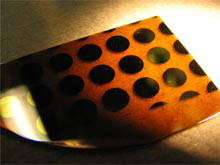Making Gasoline from Carbon Dioxide
"Aided by a catalyst, the electrons react with carbon dioxide to form carbon monoxide at the electrode. ... To make a fuel, the carbon monoxide can be combined with hydrogento create syngas in a well-known technology called the Fischer-Tropsch process, which has been widely used to make gasoline from coal."
Chemists have shown that it is possible to use solar energy, paired with the right catalyst, to convert carbon dioxide into a raw material for making a wide range of products, including plastics and gasoline.
Understanding a history on the making of gasoline part 1
After seeing this video from the past let's see someone who's actually doing it.

The system may also be part of a solution to a continuing problem with solar energy. For solar panels to be useful when the sun isn’t shining, the electricity they produce has to be stored. A potentially practical way of doing that is by converting the electrical energy into chemical energy. One popular approach is to use solar cells to produce hydrogen, which could then be used in fuel cells. But hydrogen gas is much more difficult to transport and store than are liquid fuels, such as gasoline, which contain far more energy by volume than hydrogen does. The UCSD system shows that it is possible to use solar energy to make carbon monoxide that then, together with hydrogen, can be converted into gasoline. Currently, carbon monoxide is made from natural gas and coal. But carbon dioxide is a more attractive raw material in part because it’s very cheap–indeed, it’s something industrial companies will pay to get off their hands, Jessop says. “There are very few chemicals which are cheaper than free, and carbon dioxide is one of them,” he says.
History on how gasoline is made
In the prototype device, sunlight passes through carbon dioxide dissolved in a solution before being absorbed by a semiconductor cathode, which converts photons into electrons. Aided by a catalyst, the electrons react with carbon dioxide to form carbon monoxide at the electrode. At the anode–a catalyst made of platinum–water is converted into oxygen.
To make a fuel, the carbon monoxide can be combined with hydrogen to create syngas in a well-known technology called the Fischer-Tropsch process, which has been widely used to make gasoline from coal. With the new process for creating syngas, however, fossil fuels could be unnecessary.
The system–which Kubiak began developing as a way of manufacturing oxygen for manned missions to Mars, which has a carbon-dioxide-rich atmosphere–is still a work in progress. In the first prototype, only about half of the energy needed for the reactions was supplied by the sun, with the rest coming from outside electricity. That’s because the researchers decided to prove the concept using silicon as the semiconductor. They are now working with a gallium-phosphide semiconductor, which has exactly the right electronic properties to drive the necessary reactions using sunlight alone.
At this early stage–Kubiak says that commercial systems could be 10 years away–the efficiency and economics of making fuels this way aren’t known. Kubiak says it’s likely that for large-scale applications, his group will need to use catalyst-coated nanoparticles to increase surface area, speeding up reactions
Scientists have long dreamed of mimicking photosynthesis, by using the energy in sunlight to knit together hydrocarbon fuels from carbon dioxide (CO2) and water. Now, a cheap new chemical catalyst has carried out part of that process with record efficiency, using electricity from a solar cell to split CO2 into energy-rich carbon monoxide (CO) and oxygen. The conversion isn’t yet efficient enough to compete with fossil fuels like gasoline. But it could one day lead to methods for making essentially unlimited amounts of liquid fuels from sunlight, water, and CO2, the chief culprit in global warming.
The new work is “a very nice result,” says John Turner, a renewable fuels expert at the National Renewable Energy Laboratory in Golden, Colorado.
The transformation begins when CO2 is broken down into oxygen and CO, the latter of which can be combined with hydrogen to make a variety of hydrocarbon fuels. Adding four hydrogen atoms, for example, creates methanol, a liquid fuel that can power cars. Over the last 2 decades, researchers have discovered a number of catalysts that enable that first step and split CO2 when the gas is bubbled up through water in the presence of an electric current. One of the best studied is a cheap, plentiful mix of copper and oxygen called copper oxide. The trouble is that the catalyst splits more water than it does CO2, making molecular hydrogen (H2), a less energy-rich compound, says Michael Graetzel, a chemist at the Swiss Federal Institute of Technology in Lausanne, whose group has long studied these CO2-split




No comments:
Post a Comment